All about daisies
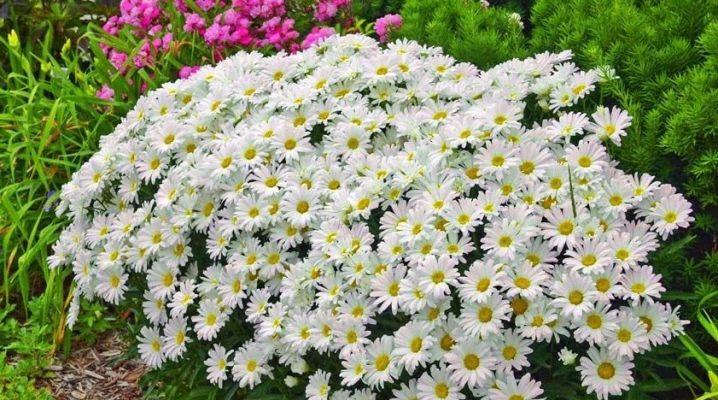
One of the most famous flowers is undoubtedly chamomile. This plant is widely used in landscape design, it can be found in almost every country house, in vegetable gardens and front gardens, it has a delicate appearance and a pleasant unobtrusive aroma. Let us dwell in more detail on its description, structure, varieties, as well as the rules of cultivation.
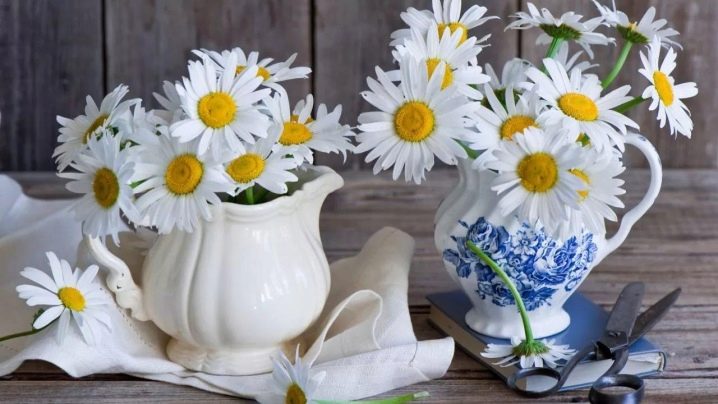
Description
First, a little history. Common field chamomile in nature grows everywhere in Russia and Europe, as well as in North America. It is known that they grew even in North Africa. But local peoples believed that daisies attract evil spirits, so they completely destroyed them.
In Latin, chamomile sounds like matricaria. The name of the flower was invented in Poland, in the 16th century, at the same time the first botanical description of this culture was made. In the middle of the 17th century, the plant attracted the attention of European breeders and from that moment scientists began to develop cultivars and varieties that are now widely used in horticulture.
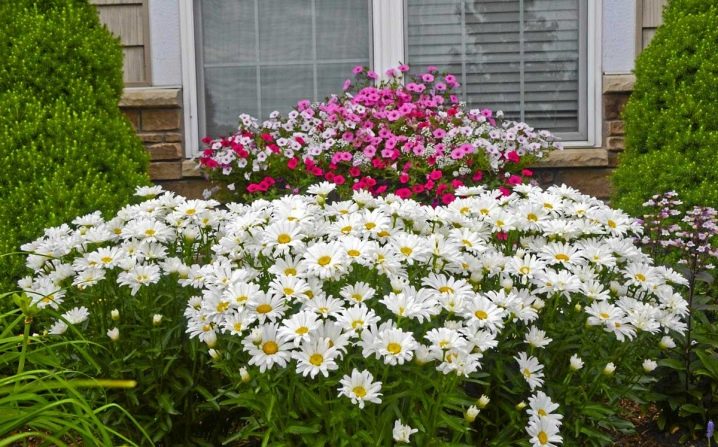
So, chamomile is herbaceous flowering plant from the Astrov family. This is a rather powerful branched bush, the height of which, depending on the characteristics of the variety, can vary from 15 cm to 1 m. The leaves look oblong, jagged at the edges, the color is bright green. A dense rosette is formed from below. The root system is branched, quite stable, but at the same time shallow.
The flowers are collected in inflorescences in the form of baskets with a diameter of 7 to 15 cm. At the same time, the flowers are simple, semi-double, and also double. In the overwhelming majority of cases, the color is white, the core is golden yellow.
Although in recent years, through the efforts of breeders, new varieties of chamomile with petals of delicate pastel shades have been bred.
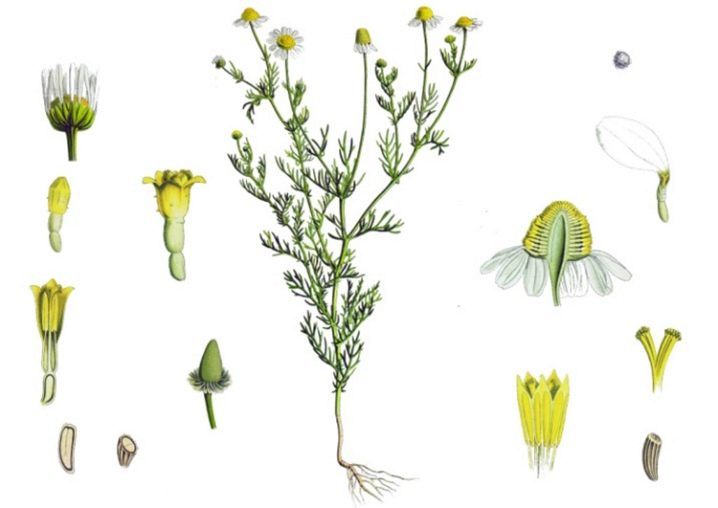
Varieties and types
In comparison with wild forest and meadow daisies, domesticated and domestic species have significant differences:
- larger flowers;
- active bud formation;
- longer flowering time;
- the possibility of re-blooming of bushes in late summer - early autumn.
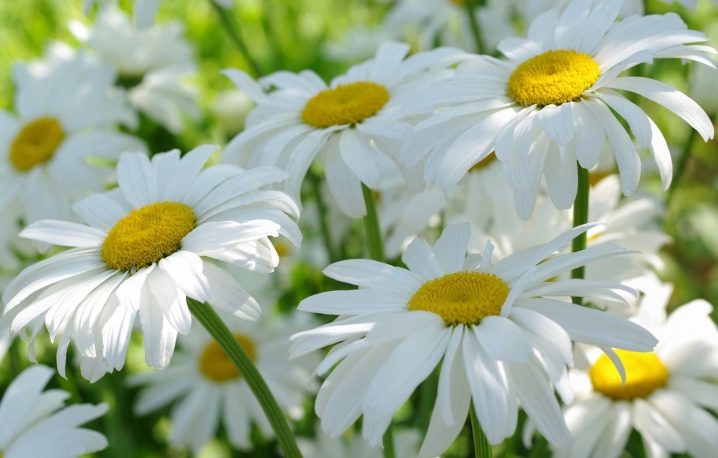
In total, breeders have about 2 dozen varieties of chamomile. They differ in the height of the bush, the diameter of the inflorescences, and the shade of the petals. Among them there are both garden varieties and indoor varieties. The following types and varieties are especially popular.
- Nivyanik... A perennial bush plant with stems up to 1 m in length. This variety has become ubiquitous in the arrangement of front gardens. Most often it has white petals with a yellow core.

- German... It grows up to 45-50 cm. Chamomile is distinguished by rather large flowers and a rich aroma.
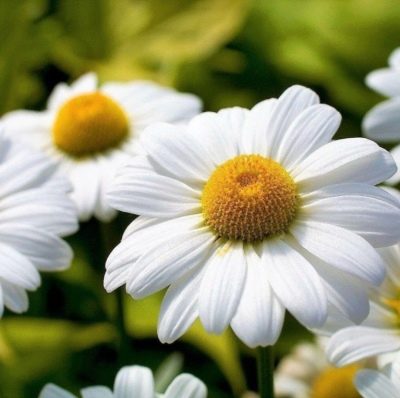
- Roman... A low-growing plant, the height does not exceed 25-30 cm. It belongs to the group of perennial daisies, usually used to decorate lawns and flower beds as part of mixborders.
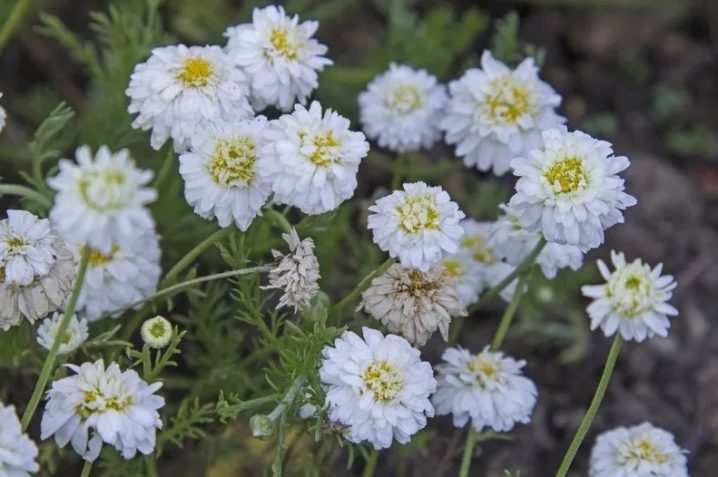
- "Silver Princess"... One of the most beautiful varieties of chamomile. Its flowers reach 10 cm in diameter, while flowering begins in early summer and lasts until the arrival of cold weather.

- "North Star". Such a flower becomes an adornment of any site. The plant is tall, up to 60-70 cm. It tolerates frost, heat and light drought well.
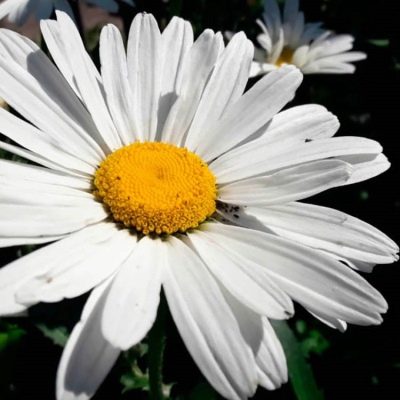
- "Winner". Large-flowered chamomile 60-90 cm high, flowers 8-13 cm in diameter.
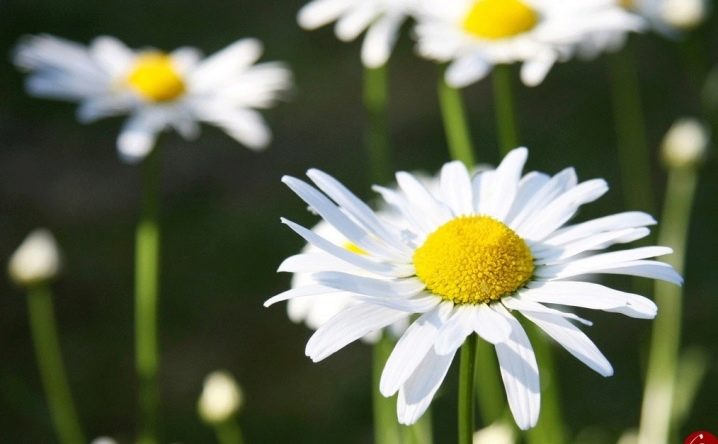
- Large-flowered aster. A real giant in the world of daisies, the height is 90 cm. It is distinguished by its unpretentiousness, resistance to drought. It is noteworthy that planting can be carried out at any time, even just before the winter frosts.
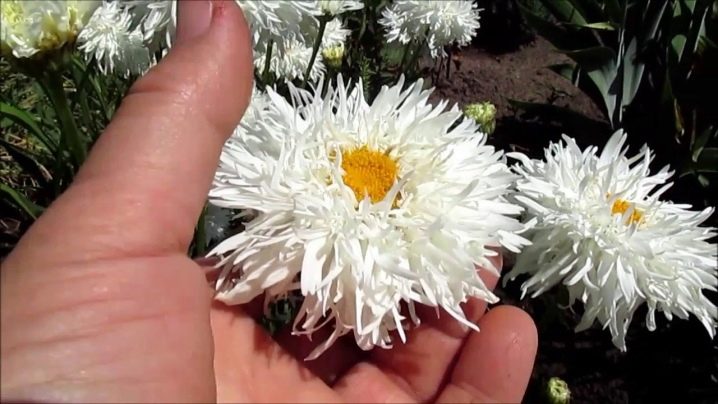
Sadovaya undersized chamomile. A compact plant, the height of which does not exceed 15 cm. White flowers are collected in miniature inflorescences. The variety became widespread in the design of alpine slides.
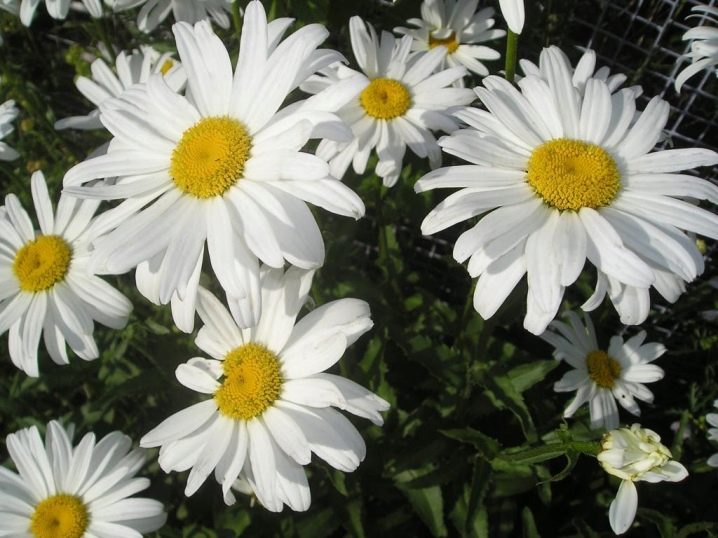
- "Snow Lady"... It differs in large beautiful inflorescences, the diameter of which reaches 15 cm. This is a perennial plant, but it practically cannot withstand winter frosts, therefore it is grown mainly as an annual.

- "Edelweiss"... It is a cold-resistant variety that lasts from mid-July until the very first frost. The flowers are combined into decorative inflorescences with a diameter of 12-13 cm, the shape resembles a chrysanthemum.
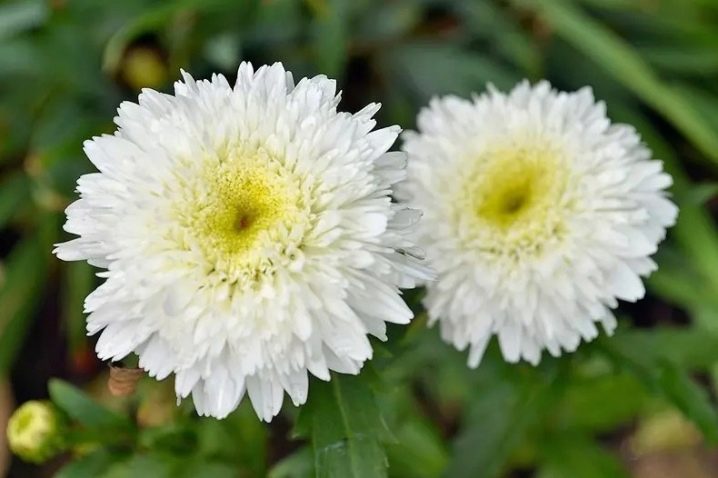
In pots, pots and flowerpots, French chamomile is most often grown.
Similar flowers
There are at least a couple of dozen annual and perennial garden plants that look very much like chamomile. Consider a few of these cultures.
- Anacyclus... Such a flower has an amazing resemblance to chamomile. Its petals are snow-white, but in the lower part they are painted in a pale pink color. The diameter is approximately 5 cm.

- Arctotis... A tall bush, the stem of which reaches 120-130 cm, although in an unfavorable habitat, the length is unlikely to exceed 20 cm.A distinctive feature of the culture is considered to be unusual flowers, the delicate petals of which have a bronze or light red hue, near the base, smoothly turning into yellow.
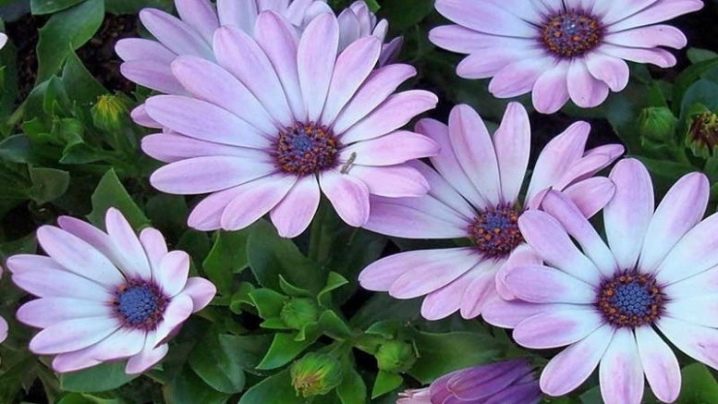
- Venidium... This flower is very much like a chamomile in its shape, it is distinguished only by yellow petals and a brown center. The length of the stems is 70-85 cm.
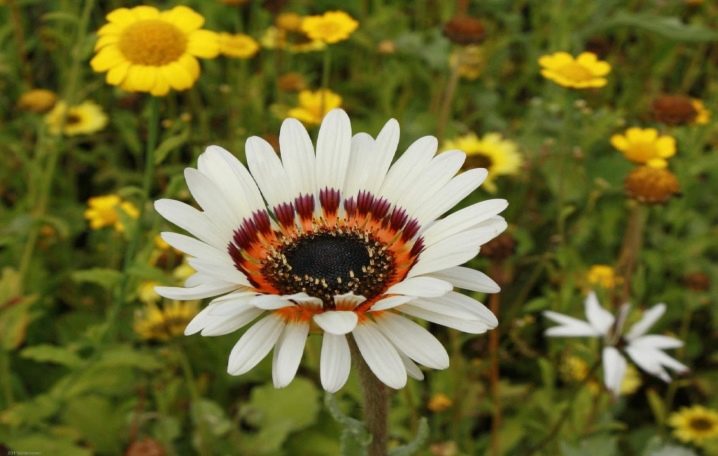
- Gatsania... Such a plant is famous for the variety of its colors. Depending on the characteristics of the variety, the petals are orange, lilac, as well as red and lemon. There are even varieties in which one shade changes gradiently into another.
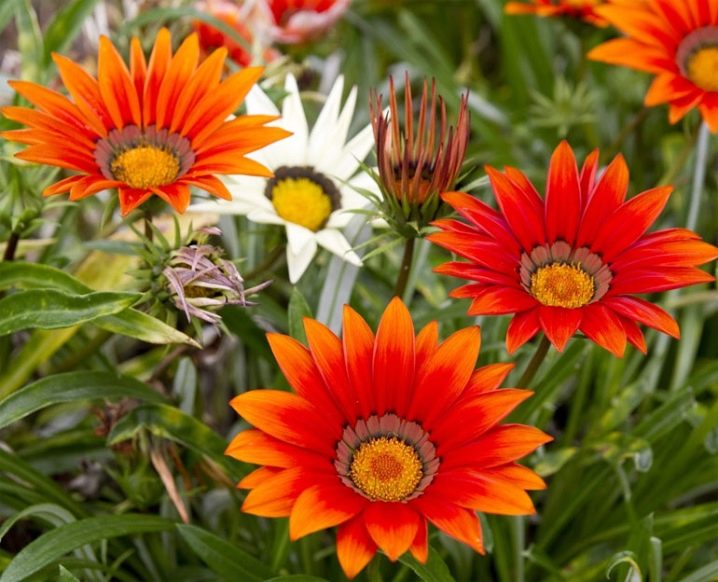
- Gerbera... One of the most popular crops that have a visual similarity to garden daisies. This culture also belongs to the Astrov family. A distinctive feature of flowers is that they retain their fresh appearance for a long time even after cutting. Gerberas can be of any color except blue.
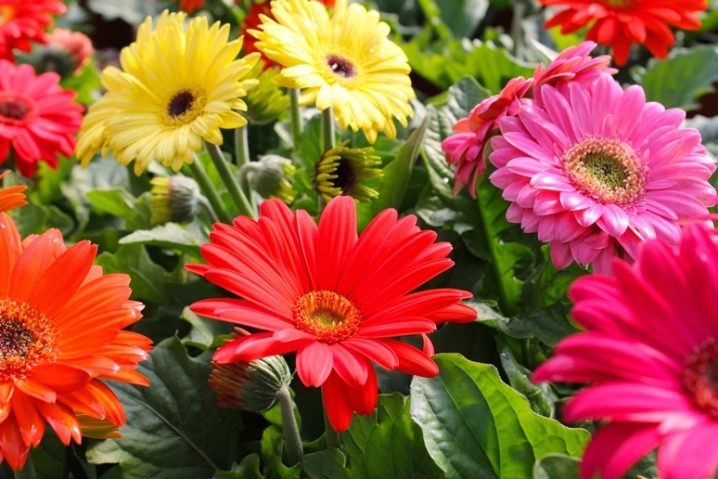
- Doronicum... Perennial with a height of 20 to 90 centimeters. The flowers are yellowish-orange, 6-10 cm in diameter.
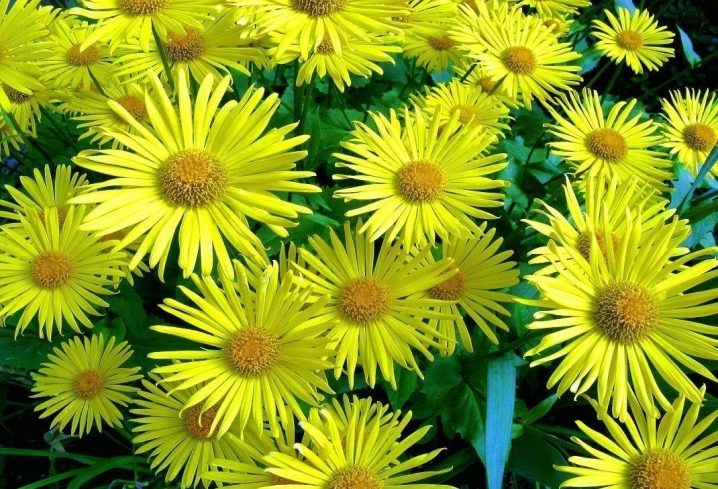
- Calendula... Like ordinary chamomile, this plant has not only decorative attractiveness, but also medicinal properties. It is distinguished by medium-sized flowers of rich orange color. A distinctive feature of the culture is the ability to reproduce by self-seeding.
If you do not take action in a timely manner, then the flowers will rapidly spread throughout the garden area.
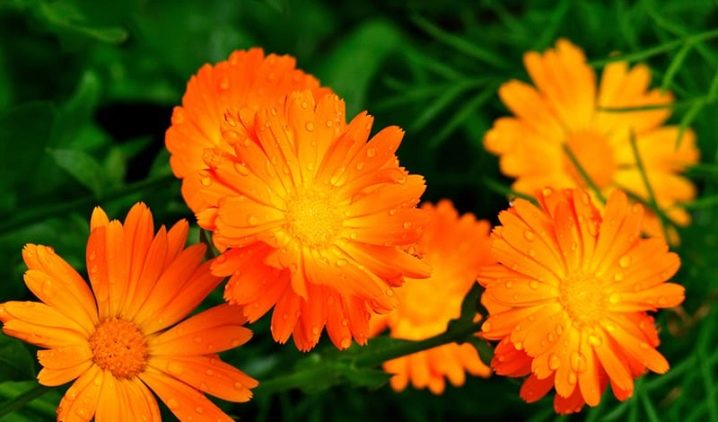
- Kosmeya... These are tall bushes about 80-150 cm long. They differ in external beauty combined with unpretentiousness. Kosmeya is able to grow even on the most depleted soils, it is not afraid of wind and frost. The flowers of the plant resemble chamomile, but are colored in light pink, red, and also lilac shades.
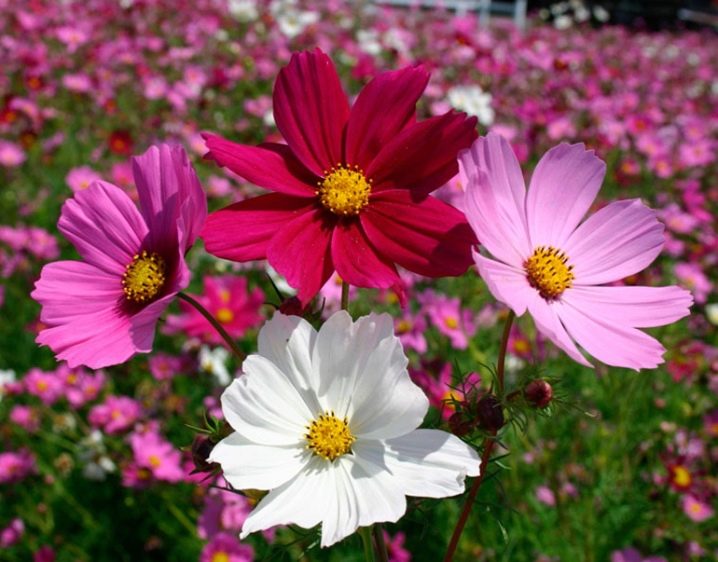
- Coreopsis... Depending on the varietal characteristics, the height of such a plant can vary from 70 to 100 cm, and the diameter of the flowers - from 5 to 8 cm. It can have different solar undertones: from pale yellow to rich orange.

Necessary growing conditions
For successful growth and development, chamomiles require a sandy soil with a high lime content. The ground should be light, loose, and necessarily neutral. In acidified substrates, you will get frail, stunted bushes with sparse and small flowers.
Therefore, crushed chalk or dolomite flour should first be added to such soil at the rate of 2 kg per 5 sq. m of landing area.

Immediately before planting, you should dig up the soil with the addition of organic fertilizers. For one square meter of a flower bed, you should take:
- a bucket of river sand;
- a bucket of leafy earth;
- two buckets of compost or humus;
- half a bucket of chopped wood ash.
You should also add 2 tbsp. l. potassium sulfate and superphosphate.
Chamomile does not tolerate cold northerly winds, so it must be protected from drafts. These flowers do not like groundwater close to the surface. Despite the fact that the root system of chamomile is shallow, the plant needs a lot of oxygen, and excess water will block its access to the roots.
Due to the fact that chamomile is often affected by aphids, you should not plant it next to roses. But with phlox, lilies, daylilies and geraniums, it gets along well.
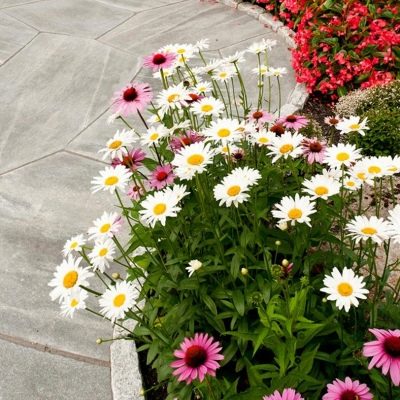
Landing
Chamomile seedlings begin to be planted for seedlings in mid-March at home or in a greenhouse. The pots are filled with a light, breathable and drained substrate; it is best to make a soil mixture of peat and river sand, taken in equal proportions. Seeds should be planted in 5-10 cm increments, sprinkled with earth and covered with foil. For germination, the container is placed near the window, but not on the windowsill, since the light penetrating through the glass is highly intense and can destroy delicate seeds.
The soil is kept moist. Every day the greenhouse is opened slightly for ventilation. If all conditions are met, the first shoots appear in 10-14 days. At this point, the film is removed and the container is placed closer to the sun's rays.
Keep in mind that plants at this stage require 14 hours of daylight hours, so you should take care of artificial additional lighting.
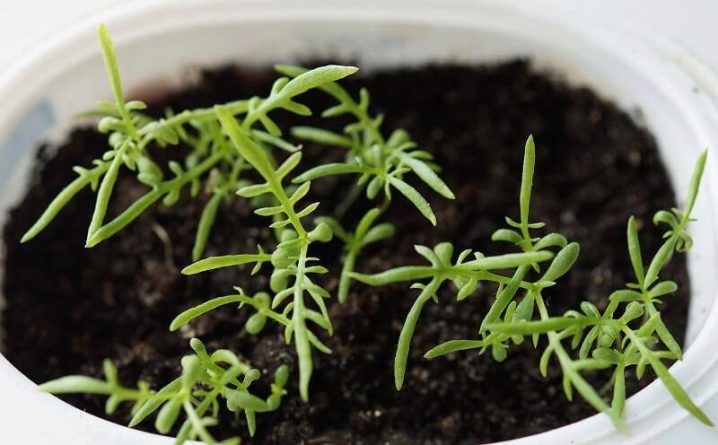
As soon as the seedlings grow to 5 cm, the seedlings should be thinned out, leaving only the strongest plants. In this case, you should not pull out excess shoots, it is better to gently pinch them from above. Otherwise, there is a high risk of damage to the roots of neighboring seedlings.
Transplanting daisies into open ground is not particularly difficult... To do this, you need to form planting pits, the diameter and depth of which is 30-40 cm. The daisies are planted, maintaining a distance between them of about 50 cm. The bush is buried so that the root collar is flush with the ground. After that, the hole is covered with a substrate and the soil is compacted with hands to minimize the formation of voids.
After planting, the flower bed is irrigated. One square meter will need about a bucket of water. From above the bed is covered with straw or needles. A layer of mulch will help to maximize moisture retention in the ground and prevent the growth of weeds.
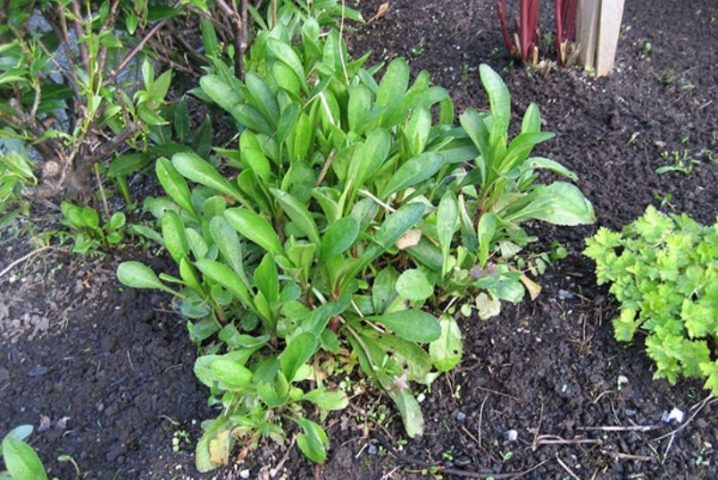
Care
Garden chamomile is one of the most unpretentious plants. But in order for it to please with its long flowering, you should adhere to some agrotechnical rules.
Watering
It is impossible to get beautiful bushes of decorative chamomiles on the site without frequent watering. Irrigation is especially important during the first month after planting the bushes in open ground, when the plants take root in a new place and adapt to the changed habitat conditions. In dry weather, during the first two weeks, chamomile is watered every other day at the rate of 1 watering can per square meter of flower bed, after which the number of waterings can be reduced to 2 times a week.
Later, the flower will only need to be moistened once a week. But if the summer is hot and dry, it is better to water the flowers more often. It is important that the soil in the flowerbed always remains moist, but without stagnation of puddles.
The day after watering, a dense crust forms on the ground. Therefore, the substrate should be loosened shallowly so as not to interfere with the access of oxygen to the roots.
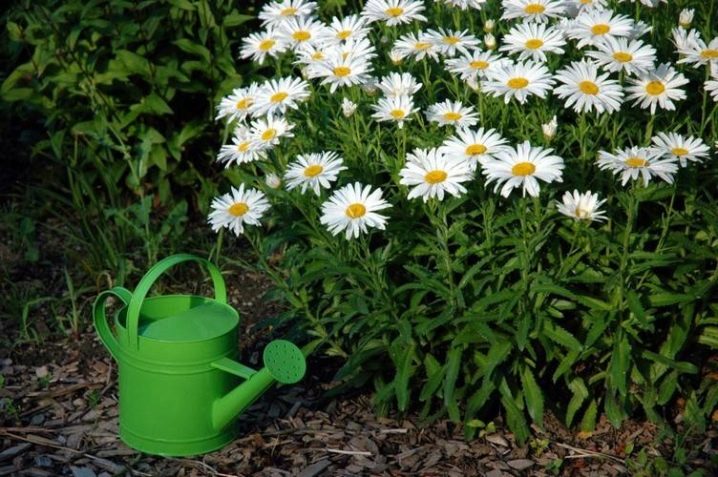
Top dressing
Perennial garden chamomiles require nutritious feeding, they are fertilized several times per season. Immediately after the snow melts in spring, plants need nitrogen nutrition: at this stage, it is advisable to add a solution of urea to the soil, diluted in a proportion of 2 tbsp. l. on a bucket of water. This volume is enough to fertilize one square meter of plantings.
At the budding stage, the bushes require potassium and phosphorus. Therefore, it is advisable to feed them with potassium sulfate and superphosphate: 2 tbsp. l. for every square meter of landings. When the plant blooms, every 3 weeks you should apply slurry diluted in a ratio of 1 to 10. In the second half of September, it is advisable to add ready-made complex mineral fertilizers to the ground. It is advisable to take those that are intended for autumn feeding of flowering perennial plants.

Reproduction
Chamomile can be propagated in several ways: by seeds, by dividing a bush or by cuttings.
Seed reproduction
When planting seeds in open ground, the optimal season is the end of spring - the very beginning of June. For sowing, sunny places are selected. Planting is carried out after the risk of recurrent frosts has finally passed, and the average daily temperature is set at around 16 degrees. After planting, the seedlings are sprinkled with a thin layer of soil mixture and covered with a film to create a greenhouse effect.
When sprouts appear, the chamomile needs to be thinned out, leaving only the strongest bushes.
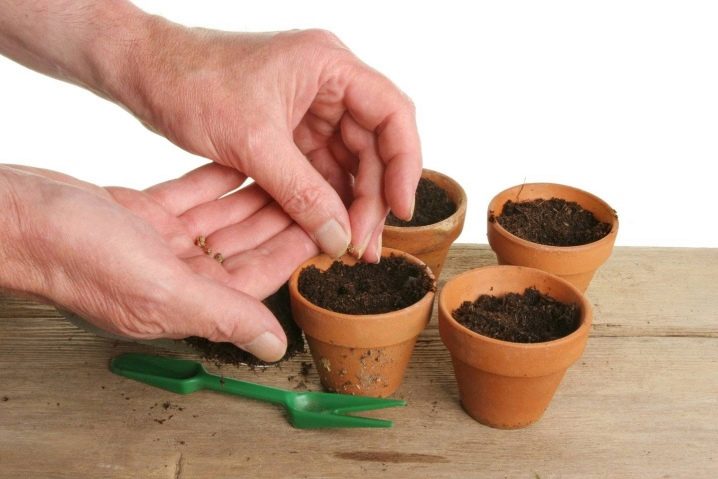
Dividing the bush
This is a very simple way to propagate chamomile, but it is important not to damage its delicate roots. It is best to carry out the procedure in the spring.... After dividing the bush into two or three parts, each plot is planted in a separate hole and a little fertilizer is added to it.
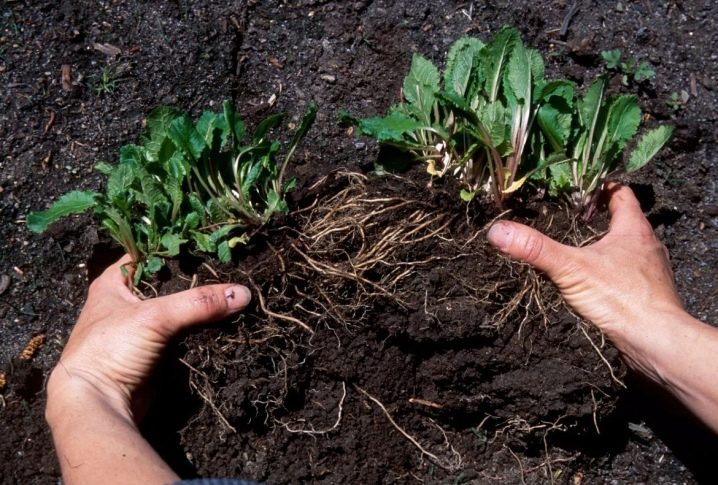
Cuttings
Propagation by cuttings in the case of chamomile does not always give the desired result. But if you are determined to try, then you need to keep in mind that cuttings should be cut before the first buds appear on the chamomile. The length of the cutting should not exceed 10-12 cm.
Tip: to speed up rooting, you need to make a small incision at the very bottom of the cutting.
The cuttings are placed in water, under favorable conditions, roots will appear on them in a week. Plants are transplanted to a flower bed after the roots grow to 4-5 cm.

Preparing for winter
After the flowering of the garden chamomile is complete, you must continue to care for the plant. In September, the bush is divided, dead shoots are removed and dry peduncles are cut off. After the temperature drops (that is, around the beginning of October), all the stems should be cut, leaving only 5 cm high columns. The cut sites are treated with a solution of potassium permanganate to prevent infectious lesions. The bed is covered with a layer of needles and leaves 40-50 cm high, and after the arrival of negative temperatures, the mulch is covered with spruce branches from above.

Diseases and pests
Failure to follow the rules of care leads to the appearance of insect pests and dangerous fungal diseases. Of the diseases, the following options will be the most common.
- Powdery mildew... It is very simple to determine the pathology: a white bloom appears on the leaves and stems of chamomile, which eventually acquires a brown tint. If untreated, the plant dries quickly and withers.
- Rust... It is expressed in the appearance of dark brown spots on the leaves from the outside. From the back, you can distinguish small bumps in which mushroom spores are located.
- Fusarium... Pathology causes root rot. In this case, the leaves turn yellow, and the plant begins to wither.
- Gray rot... With this pathology, all vegetative parts are covered with necrotic spots. It is not possible to save the bush in such a situation.
For the treatment of fungal infections, fungicidal preparations are used: "Topaz", "Kuproksat", "Fundazol". Processing is carried out three times with an interval of 5-8 days.
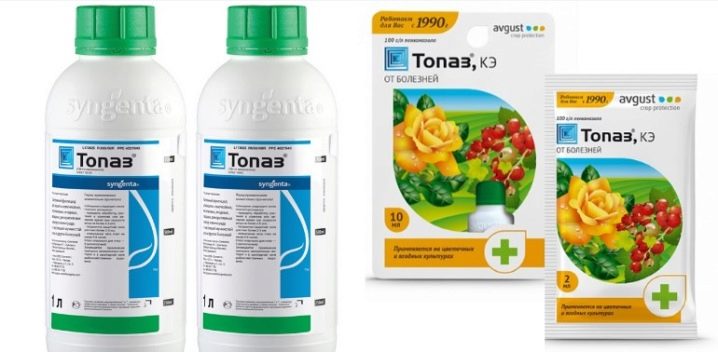
Of the pests, chamomile is attacked by the following insects.
- Thrips... They are sucking insects that feed on the plant's vital juices. When damaged, light spots appear on the leaf plates, and soon the damaged areas die off and the bush loses its attractiveness. Good effect in the fight against insects is given by "Karbofos", "Agravertin" or "Actellik".
- Wireworms... They attack the roots of the plant.To save landings from them, traps should be used. For this, small pits are formed, slices of carrots or beets are laid in them and covered with a board on top. A few days later, the shelter is removed and the gathered pests are destroyed. This treatment is repeated every week.
- Aphid... When aphids are affected, the buds are deformed and the flowers become ugly. To save the situation, it is necessary to spray with Biotlin.
- Caterpillars... If the flower is overpowered by caterpillars, the compositions "Inta-Vir", "Aladar", "Iskra" or "Extraflor" will give a good effect.
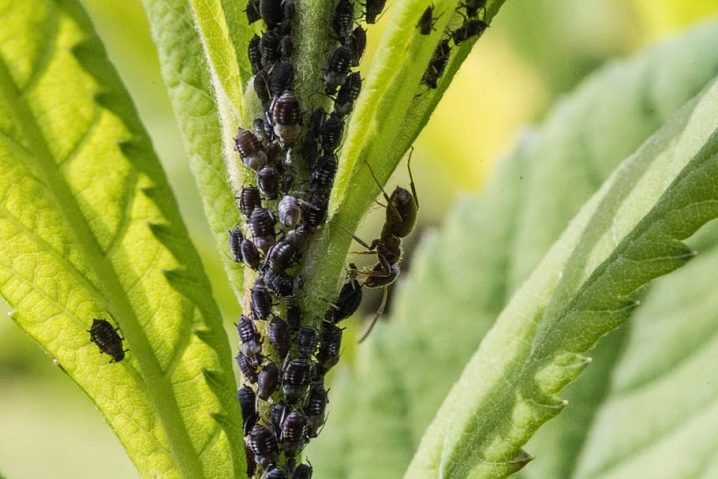































































































The comment was sent successfully.